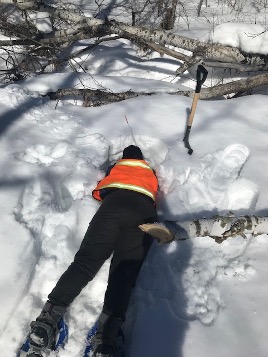by Mariel Jones, Doctoral student, Water Resources Science
In Minnesota we love to complain about snow. Is there too much? “I’ve been shoveling all day!” Not enough? “We can’t go sledding!” Snow in October? “Where’s Fall?!” Snow in May? “Where’s Spring?!” Recent snow patterns in Minnesota show that climate change is directly affecting our winters, thus creating myriad opportunities for conversations about snow.
So, let’s talk snow!

The 2022-2023 snow season was record-breaking. Above average snowfall blanketed almost the entirety of Minnesota, with the North Shore of Lake Superior accumulating two feet more than the 15-year average. In contrast, the 2023-2024 winter has had little snowfall. These extremes are more common as climate change progresses: winter temperatures climb, precipitation falls in the form of rain instead of snow, and snow melts more often during winter. Get ready for false spring Nos. 4, 5, and 6!
Although we see these effects every year, we don’t understand how they affect water availability and ecosystems downstream, and understanding these dynamics is complicated. For one, snow distribution is dependent on tree cover. Trees catch snow and cause it to evaporate back into the atmosphere. Dense coniferous canopies, like those throughout northern Minnesota, catch more snow than mixed deciduous forests in southern Minnesota. As forests in the Midwest change in composition, so will their effects on snow accumulation and melt speed.
Another factor is that Minnesota watersheds are typically flat and speckled with wetlands, ponds, and lakes; water is stored all over the surface of the state. This makes it difficult to trace the path of melting snow, which may run into the Mississippi, percolate into the ground, or drain into a wetland. This contrasts with the mountainous western United States where winter snow flows predictably downhill into reservoirs and lakes, providing 60-80% of their annual water. This begs the question: how do we better understand snow dynamics in Minnesota?
Since 2022, our teams at the University of Minnesota, Northern Arizona University, and the United States Forest Service Northern Research Station have conducted this research. Our field sites are two peatlands within the Marcell Experimental Forest in Grand Rapids, MN. We have measured snow depth and snow water equivalent (the depth of snow if it fell as rain) along grids laid out on the forest floor. These measurements, taken starting in December and continuing until the snow melts, are matched with estimations of tree coverage to examine relationships between forest canopy and snow. Initial results show that more snow accumulated in areas with less winter tree canopy; however, there are exceptions. Some areas with very sparse deciduous forest, but dense canopies (think 2-3 large trees with dense branches vs. 10-20 small trees) had more snow than expected. This discrepancy might mean there are other factors affecting snow accumulation in these areas (e.g. topography, soil temperature). We hope to learn more from this winter’s data.
To better understand flow paths, we installed soil moisture and temperature sensors at select locations throughout the watersheds. This sensor data lets us determine where there is soil frost (which can limit infiltration) and estimate how much snowmelt infiltrates the soil in spring. Last winter, little frost formed, so spring snow melt infiltrated directly into the soil instead of running off the surface. This year, shallow snow means we anticipate deeper frost depths and higher amounts of surface runoff into the peatlands.
This project will continue through 2025. With one (big) snow year under our belts and another (non-existent?) snow year in progress, we will continue to improve our scientific understanding of forests, snow, and streamflow dynamics to determine how our changing winters will affect water availability throughout the state.